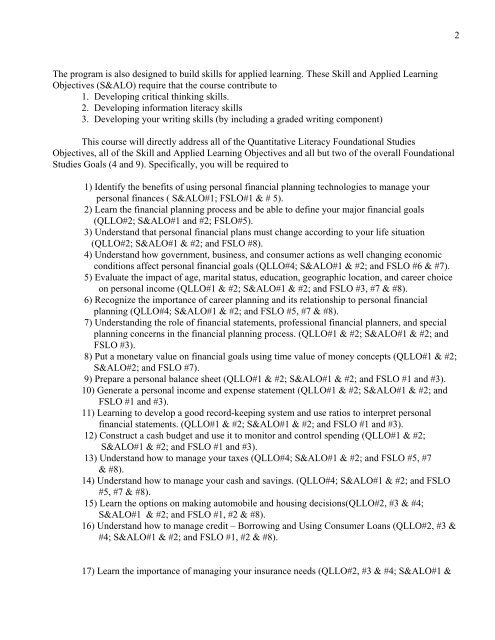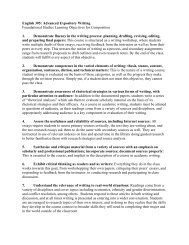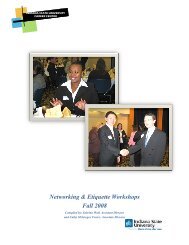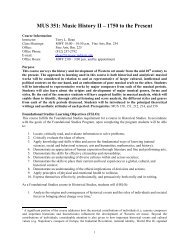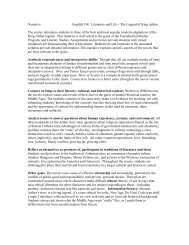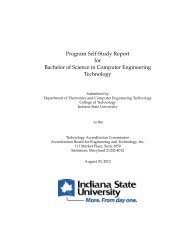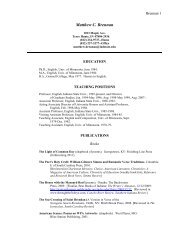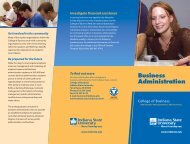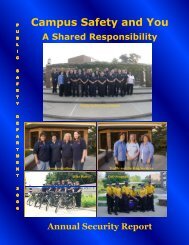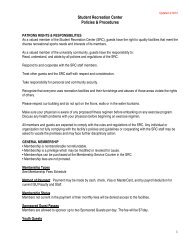Create successful ePaper yourself
Turn your PDF publications into a flip-book with our unique Google optimized e-Paper software.
2<br />
The program is also designed to build skills for applied learning. These Skill and Applied Learning<br />
Objectives (S&ALO) require that the course contribute to<br />
1. Developing critical thinking skills.<br />
2. Developing information literacy skills<br />
3. Developing your writing skills (by including a graded writing component)<br />
This course will directly address all of the Quantitative Literacy Foundational Studies<br />
Objectives, all of the Skill and Applied Learning Objectives and all but two of the overall Foundational<br />
Studies Goals (4 and 9). Specifically, you will be required to<br />
1) Identify the benefits of using personal financial planning technologies to manage your<br />
personal finances ( S&ALO#1; FSLO#1 & # 5).<br />
2) Learn the financial planning process and be able to define your major financial goals<br />
(QLLO#2; S&ALO#1 and #2; FSLO#5).<br />
3) Understand that personal financial plans must change according to your life situation<br />
(QLLO#2; S&ALO#1 & #2; and FSLO #8).<br />
4) Understand how government, business, and consumer actions as well changing economic<br />
conditions affect personal financial goals (QLLO#4; S&ALO#1 & #2; and FSLO #6 & #7).<br />
5) Evaluate the impact of age, marital status, education, geographic location, and career choice<br />
on personal income (QLLO#1 & #2; S&ALO#1 & #2; and FSLO #3, #7 & #8).<br />
6) Recognize the importance of career planning and its relationship to personal financial<br />
planning (QLLO#4; S&ALO#1 & #2; and FSLO #5, #7 & #8).<br />
7) Understanding the role of financial statements, professional financial planners, and special<br />
planning concerns in the financial planning process. (QLLO#1 & #2; S&ALO#1 & #2; and<br />
FSLO #3).<br />
8) Put a monetary value on financial goals using time value of money concepts (QLLO#1 & #2;<br />
S&ALO#2; and FSLO #7).<br />
9) Prepare a personal balance sheet (QLLO#1 & #2; S&ALO#1 & #2; and FSLO #1 and #3).<br />
10) Generate a personal income and expense statement (QLLO#1 & #2; S&ALO#1 & #2; and<br />
FSLO #1 and #3).<br />
11) Learning to develop a good record-keeping system and use ratios to interpret personal<br />
financial statements. (QLLO#1 & #2; S&ALO#1 & #2; and FSLO #1 and #3).<br />
12) Construct a cash budget and use it to monitor and control spending (QLLO#1 & #2;<br />
S&ALO#1 & #2; and FSLO #1 and #3).<br />
13) Understand how to manage your taxes (QLLO#4; S&ALO#1 & #2; and FSLO #5, #7<br />
& #8).<br />
14) Understand how to manage your cash and savings. (QLLO#4; S&ALO#1 & #2; and FSLO<br />
#5, #7 & #8).<br />
15) Learn the options on making automobile and housing decisions(QLLO#2, #3 & #4;<br />
S&ALO#1 & #2; and FSLO #1, #2 & #8).<br />
16) Understand how to manage credit – Borrowing and Using Consumer Loans (QLLO#2, #3 &<br />
#4; S&ALO#1 & #2; and FSLO #1, #2 & #8).<br />
17) Learn the importance of managing your insurance needs (QLLO#2, #3 & #4; S&ALO#1 &


